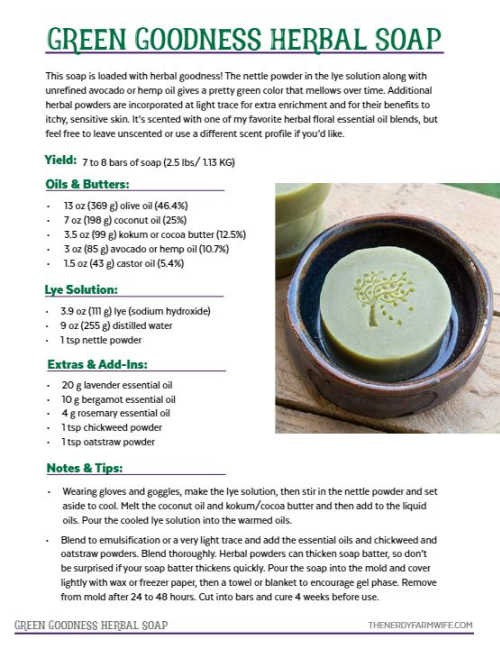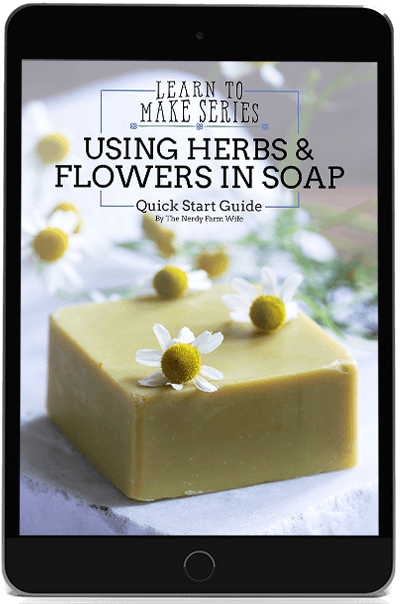12 Herbal Powders to Use in Soap
Herbal powders are a convenient way to add nourishing components and label appeal to your handmade soaps!

Instead of infusing herbs (and flowers) in oil or water for soap, you can stir small amounts of the finely powdered herbs into the:
- lye solution,
- warmed oils,
- or the soap batter at light trace.
Some ground floral powders, like calendula and chamomile, add a slightly speckled texture and color. Marshmallow root powder is often added for moisturizing and soothing properties.
Other herbs, like ground mint or basil leaves, may start off green, but will eventually discolor to brown, so use those sparingly. Two more to be aware of are ground lavender, as it turns gray-brown when mixed into soap batter, and powdered rose petals which darken to a brown or black color.
Why add herb powders to soap?
Herbal powders offer a variety of potential skin soothing benefits, label appeal, and some will even give your soap a soft color.
I’m often asked if the benefits of herbs and flowers remain in soap, and always like to refer to this article: “Ask the Experts – Saponification“
Some herbal powders act as exfoliants, so it’s wise to keep the amounts on the low side or the soap may turn out too scratchy.
Be sure to check out the Green Goodness soap recipe linked below, for an example of a soap made with 3 herbal powders!
12 Powdered Herbs for Soapmaking
Here are a dozen herbal powders to get you started, but there are so many more to explore! (My favorite source for powdered herbs is Mountain Rose Herbs.)
PPO = Per Pound of Oil in your recipe; 1 pound = 16 ounces = 454 grams
| Herb | Benefit | Amount | When to Add |
| Chamomile (Matricaria chamomilla) | anti-inflammatory, calms itchy skin | 1/2 to 1 tsp PPO | lye solution, warm oils, light trace |
| Chickweed (Stellaria media) | soothing, anti-itching, soft green natural colorant | 2 tsp PPO | warm oils |
| Chlorella (Chlorella vulgaris) | fights acne & inflammation, lovely natural green colorant | 1 tsp PPO | lye solution, warm oils, light trace |
| Echinacea (purple coneflower) (E. purpurea) | anti-inflammatory | 1/2 to 1 tsp PPO | lye solution, warm oils, light trace |
| Kelp (Ascophyllum nodosum) | skin-brightening, nutrient rich | 1/2 tsp PPO | light trace |
| Marshmallow (Althaea officinalis) | moisturizing, soothes redness & eczema | 1/2 tsp PPO | light trace |
| Moringa (Moringa oleifera) | nourishing, antioxidant-rich, soft green color | 1 tsp PPO | lye solution, warm oils |
| Nettle (Urtica dioica) | nutritive, healthy scalp & skin | 1 to 2 tsp PPO | lye solution, warm oils, light trace |
| Oatstraw (Avena sativa) | antioxidants, beneficial silica for skin & hair, soft green color | 1 tsp PPO | lye solution, warm oils, light trace |
| Rosehip (Rosa spp.) | beneficial fruit acids; combine with madder root for color | 1/2 to 1 tsp PPO | hot lye solution |
| Rosemary (Rosmarinus officinalis) | antiseptic, astringent | 1/2 tsp PPO | lye solution, warm oils, light trace |
| Yarrow (Achillea millefolium) | for damaged, oily, acne-prone skin | 1/2 tsp PPO | lye solution, warm oils |
Green Goodness Soap Recipe
For an example of a soap made using herbal powders, check out this Green Goodness soap recipe from my Soapmaking Success course! (Click on the image to be taken to the full sized recipe.)




Hi!
Can these herbs be used in melt and pour soaps? Thank you so much for all of the information you share!
Hi Annette, Yes, they sure can! I will have more melt and pour information coming to the site this year, but also have lots of ways to use flowers & herbs + melt & pour in my print book:
Easy Homemade Melt & Pour Soaps ?
https://thenerdyfarmwife.com/books/
Thank you ! I will pick up the book. Happy Fourth!
hi is a certificate available at the end of the soap course
Hi Paula! Yes, once you complete every lesson, there’s a personalized certificate of completion you can download at the end of the course.
If you ever lose the certificate or have trouble downloading it, just let me know & I can send it to you again. ?
Have you used fig leaf powder in soap? I know that fig leaves can be used in tea, but was wondering about adding to cold (or hot) process soaps.
Hi Jane, That’s one I haven’t tried yet, but it sounds interesting! Since it’s safe to use as tea, I think it’s worth a try in soap!
I use this method when experimenting with new-to-me powders:
https://thenerdyfarmwife.com/test-batches-of-soap/
If you give it a try, I’d love to hear how you like it in soap! ❤
I’m getting ready to sign up for your soap course. But, I have a question, do you ever make your own powders? I’m guessing they would need to be ground really fine.
Hi Mandi! Yes, sometimes I do make my own herbal powders.
Here’s an article I wrote on making your own orange & lemon peel powders:
https://thenerdyfarmwife.com/orange-peel-powder-soap/
and you use the same basic idea for other herbs. You just run the dried herbs through a coffee grinder, then rub that resulting powder through a fine mesh sieve to make it even finer.
It’s harder to get that ultra fine texture like commercial herb powders, but you can always strain your lye solution/oil infusion again if needed to get larger specks out.
Thank you for all this information, very helpful. I was wondering if I can use Bay leaves powder and how to safely incorporate them in my soap. I am looking for a revisited Aleppo soap, with the leaves and not the Laurel berry oil. Is it possible?
Hi Lily, That’s a great question! I haven’t used bay leaf powder in my soaps before to know how it’d do, but it’s definitely worth a try!
If it’s a spice, such as bay leaves, that can be used in daily cooking, then I usually figure it will be safe for skin care products and soap as well.
I would use a test batch to try the idea out. Here’s how I make and plan small test batches for new ideas like this:
https://thenerdyfarmwife.com/test-batches-of-soap/
It could be a good idea to test the powder in the lye solution, and then a second small test batch with the powder mixed into the oils.
Then you could compare and see which way you like best. (Or you might decide to make a soap with the powder in both the lye solution AND oils!) :)
For the same purpose, can I use Olive, Eucalyptus & Lavender leaves powder, I am excited about using only pure natural ingredients for my soaps. Would it be possible? Thank you in advance.
Hi Lily! You could definitely experiment with those too!
I’ve tried olive leaf powder before, but it’s been many years. I believe it turned an earthy shade of green, but like all natural green colorants, it will easily fade when cured or stored in light.
I suspect the eucalyptus and lavender leaf powders may turn more tan-toned, but I’m not sure.
The only thing to keep in mind is that they won’t keep any scent they might have once they go through the soapmaking process, but they’re fun to add for label appeal and sometimes natural color.
Happy experimenting! :)
Can you use the powders in Melt and Pour soaps?
Hi Denise, Yes, you sure can use herbal powders in melt and pour too! You can mix the powder with 2 to 3 times as much rubbing alcohol and stir it into your melted soap base, or infuse the herbal powder directly into the soap, similar to how I used dandelions in this recipe:
https://thenerdyfarmwife.com/dandelion-honey-melt-pour-soap/
Just use small amounts of herbal powder – about 1/2 to 1 teaspoon for every 16 ounces of soap base. Herbal powders usually turn shades of green to brown in melt and pour soap. (Stronger colors in clear soap base, softer pastels in white soap base.)
Hi Jan! I’ve been using your soap recipes for about 3 years now. I couldn’t make enough of the baby carrot soap. I have a question for you. Can I put marshmallow root powder in a castile soap recipe? Thanks so much
Hi Vandi, I’m so glad you’re enjoying the recipes! ❤
I bet marshmallow root powder would make a lovely addition to a batch of soap. I would probably try stirring it into the lye solution, after it has cooled.
Hi
Really great article. I was wondering what you think of using Vanilla powder in soaps ?
Thanks,Kim
Hi Kim, I’ve used homemade ground vanilla beans in soap before and really love the gentle texture and visual speckles it adds!
I haven’t tried vanilla powder in soap s far as I can recall though, so I’m not sure how it would do.
However, I think it’s worth a test batch!
Here’s how I try out new soapmaking ideas:
https://thenerdyfarmwife.com/test-batches-of-soap/
Hi Kim,
Enjoyed your post on herbal powders. Am I understanding correctly that if scent is your soap making goal, use of essential oil itself is the better choice?
Hi Dee! Yes, essential oils are what you want to use if you want to scent your soaps naturally.
Unfortunately herbal powders or herbal infused oils won’t hold their scent during the soapmaking process.